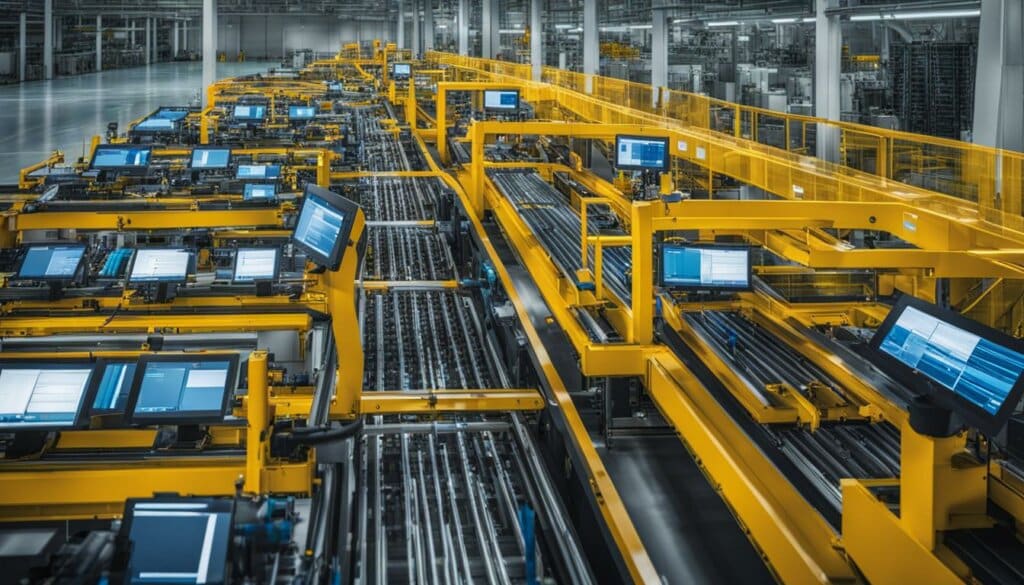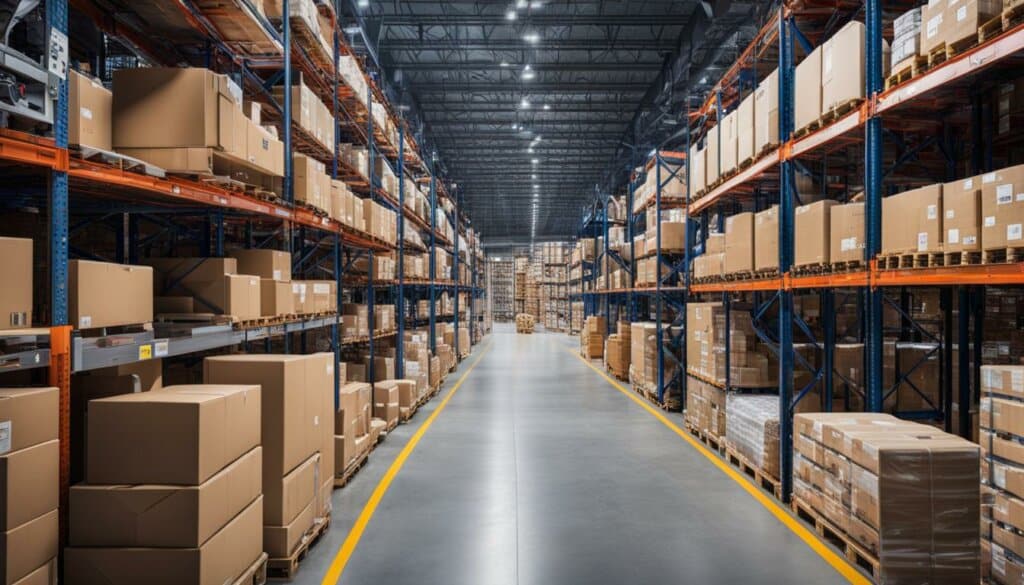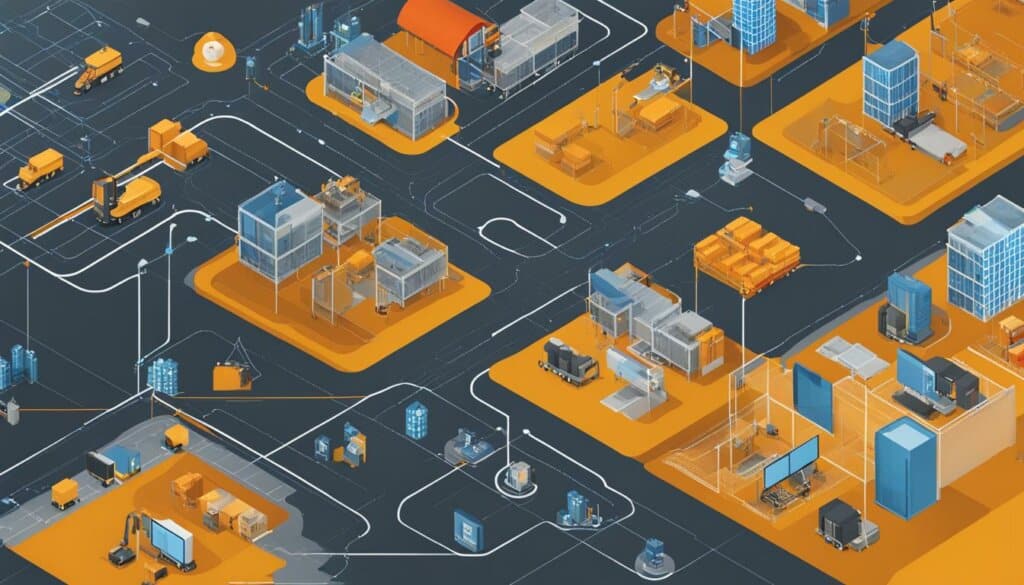Table of Contents
Integrating IoT in supply chain management brings a range of benefits. It allows for real-time visibility and tracking of products as they move through the supply chain, improving efficiency and accuracy. IoT technology enables automation and reduces manual processes, making supply chain processes faster and more efficient. It also provides actionable insights through data analytics, facilitating decision-making and continuous improvement. With IoT sensors, organizations can monitor environmental conditions, track assets, ensure product quality, and improve inventory management. Implementing IoT in the supply chain offers transparency, speed, and sustainability.
IoT in Supply Chain Management: A Paradigm Shift
Before the integration of IoT in supply chain management, there was a lack of continuity across processes. The different nodes of the supply chain, such as the factory floor, warehouse, and loading dock, were disconnected and lacked real-time visibility. IoT solutions solve this problem by providing continuous visibility and real-time tracking of products as they move throughout the supply chain. This paradigm shift allows organizations to have full visibility and understanding of their supply chain operations at all times.
Implementing IoT in supply chain management brings about a transformation in the way organizations manage their operations. With IoT devices and sensors deployed across the supply chain, organizations gain real-time visibility into the movement of products, enabling them to track and monitor their location, condition, and other crucial metrics. This level of visibility provides organizations with the ability to make data-driven decisions, optimize processes, and proactively address any issues or delays that may arise. Furthermore, IoT solutions bridge the gap between different nodes of the supply chain, creating a connected ecosystem that allows for seamless communication and collaboration.
The integration of IoT in supply chain management also ensures continuity and operational efficiency. By leveraging IoT solutions, organizations can automate manual processes, reducing the risk of errors and delays. This automation leads to improved efficiency, allowing for faster and smoother operations throughout the supply chain. Additionally, IoT technology enables real-time data collection and analysis, providing organizations with actionable insights that facilitate decision-making and continuous improvement. With IoT in supply chain management, organizations can achieve enhanced visibility, improved efficiency, and increased customer satisfaction.
| Metrics | Before IoT Integration | After IoT Integration |
|---|---|---|
| Order Fulfillment Time | 7 days | 3 days |
| Inventory Accuracy | 80% | 95% |
| On-time Delivery | 75% | 90% |
| Customer Complaints | 10 per month | 2 per month |
IoT Technology and Supply Chain Efficiency
Integrating IoT technology into supply chain management can significantly enhance efficiency, automation, and accuracy. By harnessing the power of IoT devices and sensors, organizations can streamline their supply chain processes, reduce manual labor, and achieve faster operational speeds.
One of the key benefits of IoT technology in supply chain management is the ability to automate manual processes. IoT devices, such as barcode scanners and RFID tags, can collect and transmit real-time data about inventory, production, and transportation. This automation eliminates the need for manual data entry and reduces the risk of human error, resulting in improved accuracy and efficiency.
With IoT-enabled supply chain processes, organizations can also achieve greater speed in their operations. Real-time data collection and analysis allow for immediate visibility and rapid decision-making. This enables organizations to proactively address issues, optimize routes, and minimize delays, ultimately leading to faster and more reliable supply chain operations.

Furthermore, IoT technology enhances accuracy in supply chain management. By providing real-time data on inventory levels, location tracking, and environmental conditions, organizations can ensure that the right products are at the right place at the right time. This accuracy helps prevent stockouts, optimize inventory management, and improve customer satisfaction.
Overall, integrating IoT technology into supply chain management brings significant improvements in efficiency, automation, speed, and accuracy. The ability to automate manual processes, achieve real-time visibility, and make data-driven decisions leads to streamlined operations and enhanced customer experiences.
Enhancing Supply Chain Visibility with IoT
Supply chain management is a complex process that involves multiple stakeholders, numerous touchpoints, and the coordination of various activities. One of the significant challenges in supply chain management is maintaining visibility throughout the entire process. This is where the integration of Internet of Things (IoT) technology comes into play, offering real-time tracking and monitoring capabilities that enhance supply chain visibility.
With IoT devices and sensors, organizations can track the location and condition of products, containers, and vehicles at every stage of the supply chain. Real-time visibility enables organizations to identify bottlenecks, track delivery status, and optimize logistics operations. For example, IoT sensors can monitor environmental conditions such as temperature and humidity, ensuring that perishable goods are stored in optimal conditions.
Furthermore, IoT technology facilitates asset tracking, allowing organizations to have complete visibility over their assets. By leveraging IoT asset tracking devices, organizations can monitor the movement of goods, identify potential delays or deviations, and take immediate actions to prevent any disruptions. This not only ensures the timely delivery of products but also enhances overall supply chain efficiency.
In summary, integrating IoT technology in supply chain management enhances visibility by providing real-time tracking and monitoring capabilities. With IoT devices and sensors, organizations can gain valuable insights into the location, condition, and movement of products and assets throughout the supply chain. By leveraging this enhanced visibility, organizations can make informed decisions, mitigate risks proactively, and optimize their supply chain operations.
| Benefits of Enhancing Supply Chain Visibility with IoT | Examples |
|---|---|
| Improved logistics efficiency | Real-time tracking of delivery status |
| Enhanced product quality control | Monitoring environmental conditions to ensure optimal storage |
| Efficient asset tracking | Real-time monitoring of asset movement and location |
| Optimized supply chain operations | Identification of bottlenecks and process optimizations |
Improving Inventory Management with IoT
IoT technology revolutionizes inventory management by providing real-time data and automation capabilities. With IoT devices and sensors deployed throughout the supply chain, organizations gain instant visibility into their inventory status, enabling them to make informed decisions about replenishment and preventing stockouts. Handheld scanning devices and portal readers automate inventory updates, improving workflow efficiency and reducing manual errors.
One of the key benefits of IoT in inventory management is the ability to track and monitor inventory levels in real-time. This allows organizations to optimize their inventory levels, preventing under or overloading and minimizing holding costs. By using IoT-enabled inventory systems, businesses can streamline their processes, reduce waste, and improve overall efficiency.
Another advantage of IoT in inventory management is the automation of data collection and analysis. IoT devices provide real-time data on inventory movement, allowing organizations to monitor stock levels, track item locations, and identify any discrepancies or anomalies. This automation reduces the need for manual data entry, saving time and improving data accuracy.
| Benefits of IoT in Inventory Management |
|---|
| Real-time visibility into inventory levels |
| Optimization of inventory levels and reduction of holding costs |
| Automation of data collection and analysis |
| Improved accuracy in inventory tracking |
| Streamlined processes and reduced manual errors |

IoT also enables organizations to implement predictive analytics in inventory management. By analyzing real-time data, they can identify patterns and trends in demand, allowing for proactive decision-making and better inventory forecasting. This helps prevent stockouts and ensures that the right quantity of products is available at the right time.
In conclusion, IoT technology plays a significant role in improving inventory management. It provides real-time data, automation, and predictive analytics capabilities, enabling organizations to optimize inventory levels, streamline processes, and make data-driven decisions. By harnessing the power of IoT in inventory management, businesses can enhance efficiency, reduce costs, and meet customer demands more effectively.
IoT Solutions for Supply Chain Risk Management
The integration of IoT technology in supply chain management has revolutionized the way organizations manage and mitigate supply chain risks. With real-time data collection and predictive analytics, IoT solutions enable organizations to identify and address potential risks proactively. By continuously monitoring supply chain operations and assets, organizations can make data-driven decisions, optimize processes, and ensure business continuity.
One of the key advantages of IoT in supply chain risk management is the ability to collect real-time data from IoT sensors and devices. This data provides organizations with valuable insights into their supply chain operations, allowing them to identify any anomalies or risks that may arise. By having access to real-time data, organizations can respond quickly to any issues that may threaten the efficiency and effectiveness of their supply chain.
Predictive analytics is another crucial aspect of IoT solutions for supply chain risk management. By analyzing historical and real-time data, IoT technology can identify patterns, trends, and potential risks in supply chain operations. This allows organizations to anticipate and prevent issues before they occur, minimizing disruptions and optimizing overall supply chain performance.
Benefits of IoT Solutions for Supply Chain Risk Management:
- Real-time data collection for continuous monitoring of supply chain operations
- Predictive analytics to identify and mitigate potential risks
- Proactive decision-making based on actionable insights
- Improved business continuity and resilience
- Optimized supply chain performance and efficiency
In conclusion, IoT solutions offer significant advantages for supply chain risk management. With real-time data collection and predictive analytics, organizations can proactively identify and address potential risks, ensuring business continuity and optimizing supply chain performance. By implementing IoT technology in their supply chain operations, organizations can enhance their ability to manage risks effectively and maintain a competitive edge in the market.

Ensuring Product Quality with IoT in Supply Chain
The integration of IoT technology in supply chain management has revolutionized the way organizations ensure product quality. By leveraging IoT devices and sensors, companies can monitor environmental conditions and compliance throughout the supply chain process, leading to improved quality control and customer satisfaction.
IoT-enabled sensors play a crucial role in environmental monitoring, allowing organizations to track critical factors such as temperature, humidity, and other conditions that can affect product integrity. With real-time data provided by IoT devices, companies can proactively identify any deviations from optimal storage conditions and take immediate corrective actions to maintain product quality.
Implementing IoT solutions in the supply chain enables organizations to have real-time visibility and control over product quality, reducing the risk of delivering subpar or compromised products to customers.
Compliance with quality standards is another area where IoT technology excels. By continuously monitoring and tracking environmental conditions, organizations can ensure compliance with industry regulations and standards. This not only helps in preventing quality issues but also minimizes the risk of product recalls and associated costs. With IoT in supply chain management, companies can streamline their compliance processes and have greater confidence in their ability to deliver high-quality products.
| Benefits of Ensuring Product Quality with IoT in Supply Chain |
|---|
| Real-time monitoring of environmental conditions |
| Proactive identification and mitigation of quality deviations |
| Reduced risk of delivering subpar or compromised products |
| Improved compliance with industry regulations and standards |
Overall, the integration of IoT in supply chain management ensures product quality by leveraging real-time monitoring, proactive identification, and compliance adherence. With the power of IoT, organizations can confidently deliver high-quality products to their customers, further enhancing their reputation and competitive advantage in the market.
The Role of IoT in Asset Tracking
IoT technology plays a crucial role in asset tracking within the supply chain. By utilizing IoT devices, organizations can maintain real-time visibility of the location of products, containers, and vehicles, enhancing overall operational efficiency and security. The integration of IoT enables organizations to implement geo-fencing, a powerful feature that allows them to set virtual boundaries and receive automated alerts if assets deviate from their intended routes or locations. This proactive approach to asset tracking helps organizations prevent loss or theft and ensures the timely delivery of valuable goods.
Enhancing Visibility and Control
One of the key advantages of IoT in asset tracking is the ability to have real-time location information at your fingertips. With the use of IoT-enabled tracking devices, organizations can effortlessly monitor the movement of assets throughout the entire supply chain. This enhanced visibility and control allow for greater agility in responding to potential delays or bottlenecks, ultimately improving customer satisfaction and optimizing supply chain performance.
“The integration of IoT in asset tracking allows organizations to have real-time visibility and control over the location of their valuable assets.”
Optimizing Supply Chain Operations
By leveraging IoT technology for asset tracking, organizations can optimize their supply chain operations in multiple ways. With real-time location data, they can optimize routing, reducing transportation costs and improving delivery times. Additionally, IoT devices provide valuable data on asset utilization, helping organizations identify inefficiencies and make informed decisions to streamline their operations. As a result, organizations can maximize their resources, minimize downtime, and ensure the smooth flow of goods throughout the supply chain.
| Benefits of IoT in Asset Tracking | Examples |
|---|---|
| Real-time location tracking | Monitoring the movement of products, containers, and vehicles |
| Geo-fencing | Setting virtual boundaries and receiving automated alerts for asset deviation |
| Improved visibility and control | Effortlessly monitoring assets throughout the supply chain |
| Optimized routing | Reducing transportation costs and improving delivery times |
| Data-driven decision-making | Utilizing asset utilization data to identify inefficiencies and streamline operations |
IoT and Warehouse Management
IoT technology is revolutionizing warehouse management by enabling automation and the use of smart materials. With IoT devices and sensors, organizations can streamline workflows, improve productivity, and enhance overall warehouse efficiency.
One of the key advantages of IoT in warehouse management is the ability to automate processes. IoT-enabled devices can automate inventory management, picking, and packing, reducing the need for manual labor and minimizing human errors. This automation not only speeds up operations but also improves accuracy and reduces costs, resulting in more efficient warehouse management.
IoT technology also allows for the use of smart materials in warehouse operations. Smart materials, such as RFID tags and sensors, can be attached to inventory items, pallets, and even shelving units. These materials provide real-time data on inventory levels, location, and condition, allowing warehouse managers to have complete visibility and control over their inventory. By utilizing smart materials, organizations can optimize storage space, minimize stockouts, and improve inventory accuracy.
Benefits of IoT in Warehouse Management:
- Automation of inventory management, picking, and packing processes
- Improved productivity and efficiency
- Enhanced accuracy and reduced human errors
- Real-time visibility of inventory levels, location, and condition
- Optimization of storage space
- Minimization of stockouts and overstocking
Overall, the integration of IoT in warehouse management offers significant advantages in terms of automation, efficiency, and visibility. By leveraging IoT technology and smart materials, organizations can create smart warehouses that optimize operations, improve inventory management, and ultimately drive business success.
| Benefits of IoT in Warehouse Management |
|---|
| Automation of inventory management, picking, and packing processes |
| Improved productivity and efficiency |
| Enhanced accuracy and reduced human errors |
| Real-time visibility of inventory levels, location, and condition |
| Optimization of storage space |
| Minimization of stockouts and overstocking |
Implementing IoT in Supply Chain Logistics
Implementing IoT solutions in supply chain logistics can revolutionize the way organizations manage their operations. With the automation and real-time tracking capabilities provided by IoT technology, logistics processes can become more efficient, transparent, and cost-effective.
By integrating IoT devices and sensors into their logistics operations, organizations can automate manual tasks such as inventory management, order processing, and delivery tracking. This automation reduces the risk of errors and delays, improving overall operational efficiency. IoT-enabled tracking devices empower organizations with real-time visibility into the location and status of shipments, allowing them to proactively manage delays, reroute shipments, and ensure on-time deliveries.
The transparency provided by IoT technology is another significant benefit. Organizations can have complete visibility into storage conditions, transportation routes, and overall supply chain operations. This transparency enables organizations to identify bottlenecks, streamline processes, and optimize resource allocation. By having access to accurate and real-time data, organizations can make informed decisions to improve their supply chain logistics.
| Benefits of Implementing IoT in Supply Chain Logistics |
|---|
| Automation of manual tasks |
| Real-time tracking and visibility |
| Improved efficiency and cost-effectiveness |
| Enhanced transparency and decision-making |
The implementation of IoT in supply chain logistics offers numerous advantages for organizations. It empowers them to optimize their operations, reduce costs, and provide better customer experiences through improved efficiency, transparency, and real-time tracking capabilities.
Real-life Example: Smart Warehousing
“By implementing IoT technology in our warehouse, we were able to automate inventory management and improve overall efficiency. The IoT-enabled devices provided us with real-time visibility into inventory levels and allowed us to track the movement of goods throughout the warehouse. This visibility enabled us to streamline our picking and packing processes, reducing errors and improving order accuracy. The implementation of IoT in our supply chain logistics has been a game-changer for our operations.”
– Supply Chain Manager, XYZ Company
The real-life example above highlights how IoT technology has transformed warehouse management and supply chain logistics. By embracing IoT solutions, organizations can unlock new levels of efficiency, visibility, and control over their logistics operations.
Conclusion
The integration of IoT in supply chain management brings a multitude of benefits. By automating manual tasks and providing real-time tracking capabilities, IoT technology improves efficiency, accuracy, and speed in supply chain processes. Organizations can now have complete visibility and transparency in their supply chain operations, enabling informed decision-making and proactive risk management.
With IoT devices and sensors, organizations can monitor environmental conditions, track assets, ensure product quality, and optimize inventory management. Real-time data and analytics provide actionable insights, leading to continuous improvement in supply chain processes. By implementing IoT solutions in supply chain logistics, organizations can streamline their operations, reduce costs, and deliver a seamless and transparent experience to customers.
In summary, the integration of IoT in supply chain management revolutionizes the way organizations manage their supply chain operations. It offers enhanced efficiency, visibility, and control, providing a competitive edge in the market. With the numerous benefits and advantages it brings, IoT is set to transform supply chain management and drive the future of the industry.
FAQ
What are the benefits of integrating IoT in supply chain management?
Integrating IoT in supply chain management brings benefits such as real-time visibility and tracking, improved efficiency and accuracy, automation, actionable insights through data analytics, and improved inventory management.
How does IoT technology enhance supply chain visibility?
IoT technology enhances supply chain visibility by providing real-time tracking and monitoring capabilities. With IoT devices, organizations can track the location and condition of products, containers, and vehicles throughout the supply chain.
What role does IoT play in inventory management?
IoT technology revolutionizes inventory management by providing real-time data and automation capabilities. IoT devices and sensors can be deployed throughout the supply chain to track and monitor inventory levels, enabling organizations to make informed decisions about replenishment and preventing stockouts.
How does IoT help in supply chain risk management?
IoT solutions play a crucial role in supply chain risk management by collecting real-time data from IoT devices and sensors. Organizations can identify potential risks and mitigate them proactively through predictive analytics and improved forecasting.
How does IoT ensure product quality in the supply chain?
IoT technology ensures product quality in the supply chain by monitoring environmental conditions such as temperature, humidity, and other critical factors that can affect product integrity. Organizations can maintain optimal storage conditions and prevent damage.
What is the role of IoT in asset tracking?
IoT technology plays a vital role in asset tracking in the supply chain. Organizations can maintain real-time visibility of the location of products, containers, and vehicles and ensure the security and timely delivery of their assets.
How does IoT transform warehouse management?
IoT technology is transforming warehouse management by enabling automation and the use of smart materials. IoT devices and sensors streamline workflows, improve productivity, and optimize storage space in warehouses.
What benefits does IoT offer in supply chain logistics?
IoT solutions offer significant benefits in supply chain logistics by improving efficiency, accuracy, and transparency through automation and real-time tracking capabilities. Organizations can streamline their processes, reduce costs, and provide customers with a seamless experience.
What benefits does integrating IoT bring to supply chain management?
Integrating IoT in supply chain management brings benefits such as improved efficiency, accuracy, speed, visibility, transparency, and sustainability, allowing organizations to gain a competitive edge in the market.
Source Links
- https://surgere.com/blog/iot-in-supply-chain-applications-benefits-and-more/
- https://imaginovation.net/blog/iot-in-supply-chain-and-logistics/
- https://www.linkedin.com/pulse/benefits-challenges-use-cases-iot-logistics-supply-chain-patel







